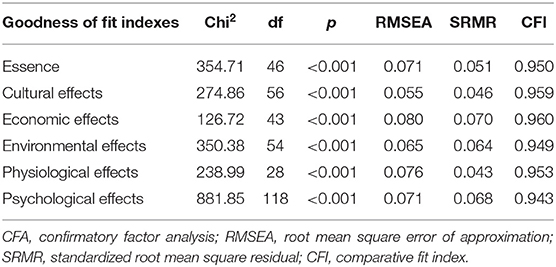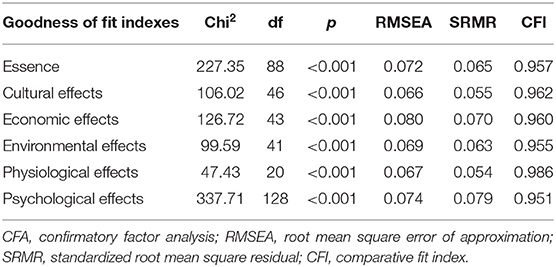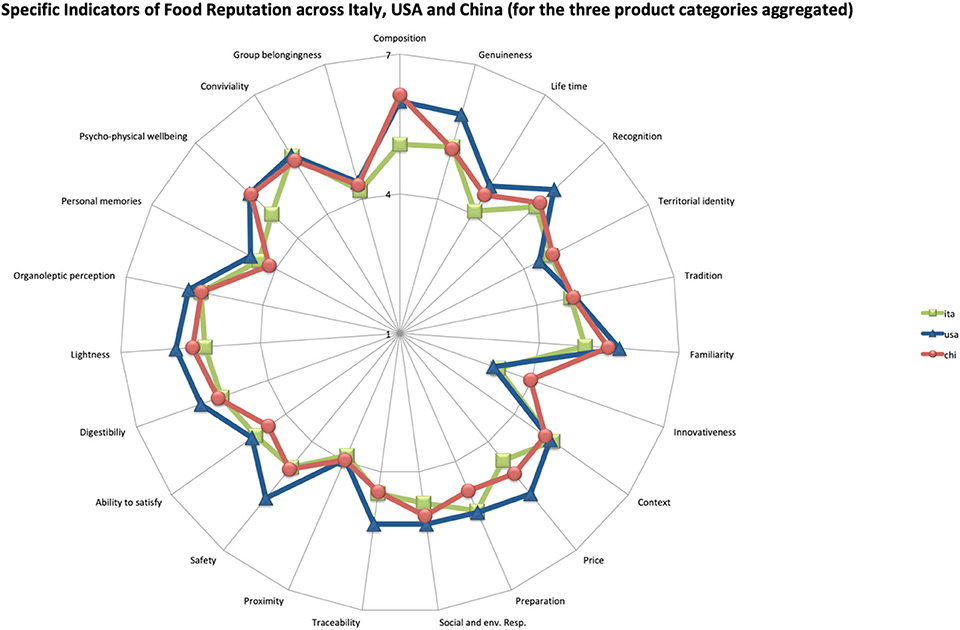- 1Department of Nutrition, Exercise and Sports, University of Copenhagen, Copenhagen, Denmark
- 2Dipartimento di Medicina Sperimentale, Sapienza Università di Roma, Rome, Italy
- 3Facoltà di Economia, Universitas Mercatorum, Rome, Italy
- 4Dipartimento di Pedagogia, Psicologia, Filosofia, Università degli Studi di Cagliari, Cagliari, Italy
- 5CIRPA—Centro Interuniversitario di Ricerca in Psicologia Ambientale, Rome, Italy
- 6Università per Stranieri “Dante Alighieri” di Reggio Calabria, Reggio Calabria, Italy
- 7Department of Psychology, Claremont Graduate University, Claremont, CA, United States
- 8School of Psychology and Behavioural Sciences, Zhejiang University, Hangzhou, China
- 9Dipartimento di Psicologia dei Processi di Sviluppo e Socializzazione, Sapienza Università di Roma, Rome, Italy
Given the food challenges that society is facing, we draw upon recent developments in the study of how food reputation affects food preferences and food choices, providing here a starting standard point for measuring every aspect of food reputation in different cultural contexts across the world. Specifically, while previous attempts focused either on specific aspects of food or on measures of food features validated in one language only, the present research validates the Food Reputation Map (FRM) in Italian, English and Chinese over 2,250 participants worldwide. Here we successfully measure food reputation across 23 specific indicators, further grouped into six synthetic indicators of food reputation. Critically, results show that: (a) the specific measurement tool of food reputation can vary across cultural contexts, and that (b) people's reputation of food products or categories changes significantly across different cultural contexts. Therefore, in order to understand people's food preferences and consumption, it is important to take into account the repertoire of cultural differences that underlies the contexts of analysis: the three context-specific versions of the FRM presented here effectively deal with this issue and provide reliable context-specific insights on stakeholders' interests, perspectives, attitudes and behaviors related to food perceptions, assessment, and consumption, which can be effectively leveraged to foster food sustainability.
Introduction
The worldwide crisis regarding food and obesity poses a series of challenges to individuals, scholars, practitioners, policy makers, and society in general (Hawkes et al., 2015). For example, to face obesity, which is predicted to affect 51% of the population by 2030, interventions are required that can generate improvements at a systemic level (Finkelstein et al., 2012). Among other possibilities, a social-psychological approach aimed at understanding why and how consumers make certain food choices could be a promising tactic to initiate such interventions. Based on collectively shared judgements about a given entity (Moscovici, 1988), the concept of reputation may shed light on a series of social-psychological processes that individuals use in their transactions with food. Because reputation is a concept that affects and orients knowledge, trust, attitude, and choices toward a specific object, it can be considered both a social process and the product of such a process (Bonaiuto et al., 2017). Reputation is defined as the “the distribution of opinions about a person or other entity, in a stakeholder or interest group” (Bromley, 2001, p. 154), and, critically, it can be used to refer to any entity, such as individuals (Emler, 1990), groups (Bromley, 2001), organizations (Riel and van Fombrun, 2007), and even food (Bonaiuto et al., 2012b, 2017).
Past research has shown that perceived characteristics of food (related to food reputation), rather than objective ones (related to information), might exert a stronger effect on consumer choices (e.g., Carfora et al., 2019). Therefore, studying food reputation can potentially provide promising insights to implement systemic interventions that would help tackling the aforementioned food and obesity crisis, among other issues. Furthermore, the conceptualization of food as a social agent implies that food should be considered as a place-specific agent: food is basic, and as such it regards biology (physiological experience), psychology (individual experience), and culture (social experience) (Rozin, 2007).
According to this logic, the general contribution of the present work is 2-fold. First, drawing upon previous results (Bonaiuto et al., 2012b, 2017), it further refines the existing scale for measuring food reputation (the Food Reputation Map; Bonaiuto et al., 2017), helping the work in the understanding of food reputation. Second, in the current research FRM is validated in three languages—Italian (its original version), English, and Chinese, across their three respective cultural settings—contributing to the understanding of food as a social agent within cross-cultural lenses (Rozin, 2007). The present work could potentially inform future research on both individual and socio-cultural factors that drive food consumption and consequently stimulate discussion, applications and interventions toward a more sustainable and ethical food consumption (Vermeir and Verbeke, 2006).
Defining Food Reputation
The rationale behind food reputation lies in the conceptualization of food as a social agent, since its features integrate both individual and collective processes (Conner and Armitage, 2002). Such a wide and open perspective, appropriate to understand food reputation, defines food features along three main areas (Bonaiuto et al., 2012b): (1) features linked to food (physical-chemical features and nutritional content); (2) features linked to the environment (economical, social and cultural features); and (3) features linked to the effects on the individual (sensorial, physiological and psychological effects). As such, food reputation can be considered both the social process of creating shared meaning around the concept of food and the result of such a process (Bonaiuto et al., 2017). Therefore, food reputation is defined as the whole set of beliefs (representations, attitudes, direct and indirect knowledge, etc.) that individuals hold about food. It includes beliefs about its antecedents and consequences (i.e., its production and its effects), its present features, its overall attractiveness (based on past direct and indirect experiences), and the future expectations related to its usage and consumption (Bonaiuto et al., 2012b, 2017). Based on this definition, an integrative model has been developed to operationalize food reputation's various facets. Established via a series of studies (qualitative, quantitative, and experimental) which indeed employed an international pool of experts (e.g., focus group) and participants (e.g., RCT experiment; see Bonaiuto et al., 2012a,b, 2017), the Food Reputation Map (henceforth, FRM) integrates the intrinsic characteristics of food, its effects on the environment, and its effects on the individual encompassing six main areas (second-order factors), namely “Synthetic Indicators” of food reputation: Essence, Cultural Effects, Economical Effects, Environmental Effects, Physical Effects, and Psychological Effects. These areas are further articulated into 23 specific areas (first-order factors), namely “Specific Indicators” of food reputation: Composition, Genuineness, Life time, Recognition, Territorial identity, Tradition, Familiarity, Innovativeness, Context, Price, Preparation, Social and environmental responsibility, Traceability, Proximity, Safety, Ability to satisfy, Digestibility, Lightness, Organoleptic perception, Personal memories, Psycho-physical well-being, Conviviality, Group belongingness.
On the basis of a series of different studies encompassing different methodological approaches—qualitative and quantitative, correlational and experimental (Bonaiuto et al., 2012a,b, 2017), these areas represent all the known possible features of food reputation.
Food Reputation in Different Cultures
It is no secret that food and its processes vary dramatically across cultures (Rozin, 2007). The simple fact that cultural anthropology is the central discipline in the field of food and culture (Counihan and Van Esterik, 2013) exemplifies the relevance and complexity of this topic. Furthermore, considering that in the past 20 years, an enormous amount of research, scientific publications, books, websites, policies, and applied interventions have been dedicated to the social and cultural aspects of food and its consumption (Counihan and Van Esterik, 2013), it appears to be a matter of fact that any consideration related to the concept and processes of reputation cannot overlook the cultural differences that would affect it. Similarly, because of food's social agent nature (Bonaiuto et al., 2017), research on food, the individuals choosing it, food choice environments and food related processes cannot overlook the changing processes that food continuously undergoes (Devine, 2005).
Based on this reasoning, a fundamental question therefore inquires whether food reputation, as defined by the FRM model, would be different across different cultural settings. To test this, and to further validate the FRM model internationally, a series of three studies in three different cultural settings have been conducted.
The Present Research
Drawing upon the FRM model (Bonaiuto et al., 2017), the present research validates the FRM questionnaire in three different cultural contexts. The resulting three validated versions of the FRM, namely FRM-ITA, FRM-ENG, and FRM-CHI (in Italian, English, and Chinese, respectively) are reported in Appendix 1. Three studies are presented. They were conducted between 2013 and 2016, in Italy first, and then in the U.S. and in China. In the three studies, the FRM has been tested with reference to the same three different goods—vegetables, peeled tomatoes and citrus fruit—chosen because they represented the three major food categories within the Italian economy (Castiglione et al., 2007; Zaccarini Bonelli, 2012) and to keep a comparable set of products.
Aims and Hypotheses
The aim of the three reported studies is to validate the measurement model for each language-specific version of the FRM initially presented by Bonaiuto et al. (2017), through a Confirmatory Factor Analysis performed via Structural Equation Modeling (SEM). Analyzing the factorial structure of the FRM using a CFA allows for testing both convergent and discriminant construct validity (Bagozzi et al., 1991; Corral-Verdugo, 2002). According to the presupposition that individuals' perceptions of food are culturally defined (Conner and Armitage, 2002; Rozin, 2007), we assume that the specific facets that operationalize food reputation (i.e., the most appropriate item-markers measuring the Specific Indicators) can differ across different cultures.
Operative Hypotheses
To verify such assumption, the operative hypotheses of Study 1, Study 2 and Study 3 concerned the adequacy of:
H1. The model fit indexes for each Synthetic Indicator of Food Reputation, which were modeled on the basis of both the initial theoretical constructs that generated the Specific Indicators of Food Reputation (Bonaiuto et al., 2012b, 2017) and the results of the principal component analyses in present and previous data (Bonaiuto et al., 2017);
H2. The correlations among Specific Indicators of Food Reputation (i.e., latent variables), in terms of size/statistical significance.
H3. The lambda coefficients connecting items (observed variables) and Specific Indicators of Food Reputation (latent variables), in terms of size/statistical significance.
Data Analysis
Reverse items were recoded such that higher scores always mean a positive reputation content. Then, data were analyzed through Confirmatory Factor Analysis via Structural Equation Modeling, to provide evidence for convergent and discriminant construct validity (Fornara et al., 2010). All analyses were conducted using the software STATA-14.
Across the three studies, the structural models performed to conduct the various CFAs validate the FRM-ITA, FRM-ENG, and FRM-CHI for each of the six Synthetic Indicators of food reputation. Following the approach of Hu and Bentler (1999) and Schreiber et al. (2006), three indexes to examine the model's goodness of fit are used here: the RMSEA, the SRMR, and the CFI, respectively with cut off values of 0.08, 0.08 (0.06 for close fit), and 0.95. Following previous research (Fornara et al., 2010), the RMSEA value was prioritized when deciding whether to accept the model. For each Synthetic Indicator of food reputation, a step-by-step iterative procedure was followed to modify the initial solution, including all items loading only on the expected factor (according to results of Bonaiuto et al., 2017). Both conceptual criteria (i.e., the retained sets of items reflected high content validity; see Fornara et al., 2010) and statistical criteria (i.e., statistical confirmation was provided by modification indexes analysis; Chou and Bentler, 1990) led to the emergent factorial solutions presented in the results section of each study. To ensure that the SEMs were identified, a constraint was added to the first indicator for each latent variable.
Study 1: FRM-ITA
Aims and Hypotheses
Study 1 applies the aims and hypotheses reported in section Aims and Hypotheses in the Italian context and therefore concerns the validation of the Italian version of the FRM, henceforth FRM-ITA.
Methods
Participants and Procedure
The paper-and-pencil survey was administrated to a total of about 1,500 participants, from June to December 2013. Using a stratified sampling procedure, participants were recruited in public areas across Italy where they were individually asked to fill-in a 10–15-min survey about food for research purposes. Randomly, each participant was assigned to one of the three possible conditions (either vegetables, peeled tomatoes, or citrus fruit, as target food object). After a preliminary data screening (incomplete survey, response set, missing data), a finalized sample of N = 1,337 was used for data analysis. The finalized sample was evenly distributed across conditions (vegetables: 32.7%; peeled tomatoes: 34.3%; citrus fruit: 33%) and composed of: women 60.4%; Italians from North (26.4%), Center (31.4%), South (34.2%) and Major Islands (9.8%) of Italy; average age: 38.3 years (SD: 14.6); lower education (9.8%), high school (53.9%), university degree (31.2%), post-graduate education (2.2%). Importantly, participants' Body Mass Index (underweight: 4.5%; healthy weight: 66.7%; overweight: 24.4%; obese: 4.4%) was similar to a comparable sample of Italians (ISTAT, 2019), meaning that our sample is not biased about a food-related relevant index.
Measures
The FRM-ITA survey consists of 102 items measured on seven-point Likert-type scales (from “Completely disagree” to “Completely agree”); it was administrated in Italian. More specifically, the FRM-ITA tool includes 10 General Food Reputation items (Bonaiuto et al., 2017), the first of which focuses on the general reputation of the evaluated product, and the remaining on product (the target object) and process (how it is created) reputation. The FRM-ITA also includes 92 items devoted to measure the 23 Specific Indicators (originally containing 4-items each) of food reputation on separate scales. In the food reputation section, participants rated each item according to the following instruction (where, for each given questionnaire, X was substituted by the specific food item label to be assessed with FRM-ITA): “For each of the following statements, please indicate to what extent the reported characteristic describes X. It is enough to express your own opinion, on the basis of what you know about X, or according to whatever you have read, seen and heard about it.” This instruction aims to trigger the reputation framework judgment of a target entity based on an individual's both direct and indirect experience of it.
The final section of the self-report questionnaire included six items that assessed gender, age, education, area of origin in Italy, height, and weight.
Results and Discussion
Following the FRM model, results of the first-order CFAs show the best measurement models (item-markers) for each Specific Indicator of food reputation: fit indices for each model measured by the FRM-ITA (H1), covariances among Specific Indicators for each Synthetic Indicator of food reputation (H2), and lambda coefficients for the retained items (H3) are reported in Tables 1, 4–9, 22, respectively.
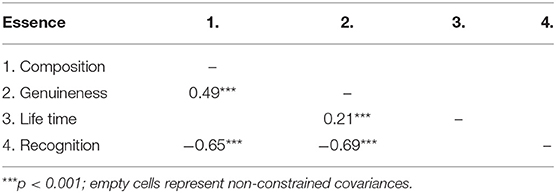
Table 4. Covariance matrix of the specific indicators of food reputation for the synthetic indicator ESSENCE of FRM-ITA–Study 1.
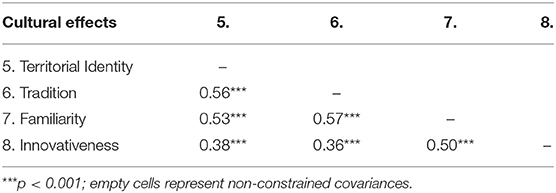
Table 5. Covariance matrix of the specific indicators of food reputation for the synthetic indicator CULTURAL EFFECTS of FRM-ITA–Study 1.

Table 6. Covariance matrix of the specific indicators of food reputation for the synthetic indicator ECONOMIC EFFECTS of FRM-ITA–Study 1.

Table 7. Covariance matrix of the specific indicators of food reputation for the synthetic indicator ENVIRONMENTAL EFFECTS of FRM-ITA–Study 1.

Table 8. Covariance matrix of the specific indicators of food reputation for the synthetic indicator PHYSIOLOGICAL EFFECTS of FRM-ITA–Study 1.
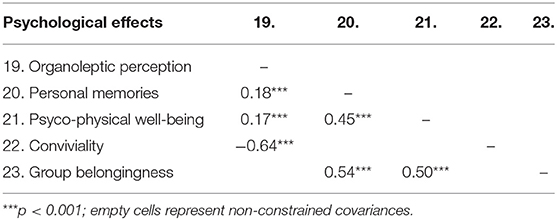
Table 9. Covariance matrix of the specific indicators of food reputation for the synthetic indicator PSYCHOLOGICAL EFFECTS of FRM-ITA–Study 1.
Essence
For the scale measuring Essence, the model includes four correlated Specific Indicators of Food Reputation (each measured by three items): Composition, Genuineness, Life Time, and Recognition. The Composition and Life Time factors, as well as Life Time and Recognition factors, were not significantly correlated.
Cultural Effects
For the scale measuring Cultural Effects, the model includes four correlated Specific Indicators of Food Reputation: Territorial Identity (three items), Tradition (three items), Familiarity (three items), and Innovativeness (four items).
Economic Effects
For the scale measuring Economic Effects, the model includes three correlated Specific Indicators of food reputation: Context (three items), Price (three items), and Preparation (four items). The factors Context and Price were not significantly correlated.
Environmental Effects
For the scale measuring Environmental Effects, the model includes four correlated Specific Indicators of food reputation: Social and Environmental Responsibility (three items), Traceability (three items), Proximity (four items), and Safety (three items). The Social and Environmental Responsibility and the Proximity factors were not significantly correlated.
Physiological Effects
For the scale measuring Physiological Effects, the model includes three correlated Specific Indicators of food reputation: Ability to Satisfy (three items), Digestibility (four items), and Lightness (three items).
Psychological Effects
For the scale measuring Psychological Effects, the model includes five correlated Specific Indicators of food reputation: Organoleptic Perception (four items), Personal Memories (three items), Psycho-physical Well-being (four items), Conviviality (three items), and Group Belongingness (four items). The following correlations among factors were not statistically significant: Personal Memories-Conviviality, Psycho-physical Well-being-Conviviality, and Conviviality-Group Belongingness.
Conclusion
Study 1 results, based on an extensive correlational survey conducted across Italy, overall confirm the measurement model theorized by the original FRM (Bonaiuto et al., 2017): the tested models produced good fit indexes (H1); first order factors (i.e., the Specific Indicators of Food Reputation) were all correlated to each other (H2) within the following Synthetic Indicators of Food Reputation: Cultural Effects and Physiological Effects; and, a total of 76 items (from the initial total of 92 items) were retained (H3). In the finalized FRM-ITA, one item was removed from each of the following Specific Indicators of Food Reputation (the relevant overarching group's Synthetic Indicator of Food reputation is indicated in brackets): Composition, Genuineness, Life time, Recognition (Essence); Territorial identity, Tradition, Familiarity (Cultural Effects); Context, Price (Economic Effects); Social and Environmental responsibility, Traceability, Safety (Environmental Effects); Ability to satisfy, Lightness (Physiological Effects); Personal memories, Conviviality (Psychological Effects). The finalized FRM-ITA is given in Appendix 1. In conclusion, in Study 1 the FRM-ITA results successfully achieved. Hence, the English version of the instrument is targeted.
Study 2: FRM-ENG
Aims and Hypotheses
Study 2 applies the aims and hypotheses reported in section Aims and Hypotheses in the U.S. context, and therefore is concerned with the validation of the English version of the FRM, henceforth FRM-ENG. It originates from the FRM-ITA, which was translated and then back-translated by a team of English and Italian native speaker scholars (including some of the authors).
Method
Participants and Procedure
The online survey was administrated to a total amount of about 400 participants, during October 2016. Participants were recruited in the USA using Amazon's Mechanical Turk (MTurk), a crowd sourcing website that allows the public to complete a variety of tasks, such as research studies. Studies using MTurk are valid and reliable (Rand, 2012; Siegel et al., 2019) and allow to reach a more demographically diverse sample (Buhrmester et al., 2011). In this study, participants volunteered to participate in a 10–15-min survey about food for research purposes. Similar to Study 1, each participant was randomly allocated to one of the three possible conditions (vegetables, peeled tomatoes, citrus fruit). After a preliminary data screening (incomplete survey, response set, missing data), a finalized sample (N = 303) was used for data analysis. The finalized sample was evenly distributed across conditions (vegetables: 33.3%; peeled tomatoes: 33.0%; citrus fruit: 33.7%) and composed of: women 52.1%; Americans: 93.4%; average age: 36.9 years (SD: 11.9); high school = 34.7%, bachelor degree = 48.2%, master degree = 12.9%, post-graduate education = 4.3%; employed full time = 62.7%, part time = 12.2%, unemployed = 8.9%, student = 5.3%, retired = 2.6%, occasional job = 2.3%, other = 5.6%; married = 47.2%, single = 35.6%, cohabitee or in a relationship = 8.6%; separated or divorced = 7.9%, widow/a = 1%. Similar to USA national data (DNPAO, 2019), where about half the people are overweight and obese, participants' Body Mass Index was: underweight, 3.8%; healthy weight, 46.4%; overweight, 29.4%; obese, 20.5%.
Measures
The FRM-ENG survey consists of the same 102 items used in the FRM-ITA (see section Method for details). The latter has been translated in English and back-translated in Italian. All items were measured on seven-point Likert-type items (from “Completely disagree” to “Completely agree”). The final section of the questionnaire included eight items measuring gender, age, education, marital status, employment, nationality, height and weight.
Results and Discussion
Following the FRM model, results of the first-order CFAs show the best measurement models (item-markers) for each Specific Indicator of food reputation: fit indices for each model measured by the FRM-ENG (H1), covariances among Specific Indicators for each Synthetic Indicator of food reputation (H2), and lambda coefficients for the retained items (H3) are reported in Tables 2, 10–15, 22, respectively.
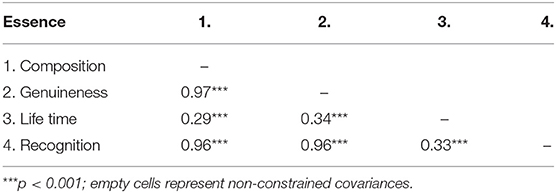
Table 10. Covariance matrix of the specific indicators of food reputation for the synthetic indicator ESSENCE of FRM-ENG–Study 2.
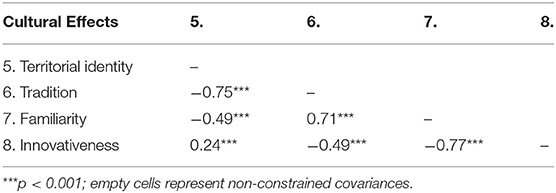
Table 11. Covariance matrix of the specific indicators of food reputation for the synthetic indicator Cultural effects of FRM-ENG–Study 2.

Table 12. Covariance matrix of the specific indicators of food reputation for the synthetic indicator ECONOMIC EFFECTS of FRM-ENG–Study 2.
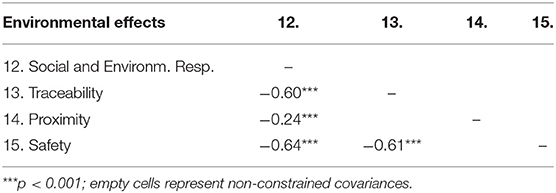
Table 13. Covariance matrix of the specific indicators of food reputation for the synthetic indicator ENVIRONMENTAL EFFECTS of FRM-ENG–Study 2.

Table 14. Covariance matrix of the specific indicators of food reputation for the synthetic indicator PHYSIOLOGICAL EFFECTS of FRM-ENG–Study 2.

Table 15. Covariance matrix of the specific indicators of food reputation for the synthetic indicator PSYCHOLOGICAL EFFECTS of FRM-ENG–Study 2.
Essence
For the scale measuring Essence, the model includes four correlated Specific Indicators of food reputation (factors), each measured by four items: Composition, Genuineness, Life Time, and Recognition.
Cultural Effects
For the scale measuring Cultural Effects, the model includes four correlated Specific Indicators of food reputation, each measured by three items: Territorial Identity, Tradition, Familiarity, and Innovativeness.
Economic Effects
For the scale measuring Economic Effects, the model includes three correlated Specific Indicators of food reputation, each measured by four items: Context, Price, and Preparation.
Environmental Effects
For the scale measuring Environmental Effects, the model includes four correlated Specific Indicators of food reputation, each measured by three items: Social and Environmental Responsibility, Traceability, Proximity, and Safety. The factors Traceability and Proximity, and Proximity and Safety were not significantly correlated.
Physiological Effects
For the scale measuring Physiological Effects, the model includes three correlated Specific Indicators of food reputation, each measured by three items: Ability to Satisfy, Digestibility, and Lightness.
Psychological Effects
For the scale measuring Psychological Effects, the model includes five correlated Specific Indicators of food reputation: Organoleptic Perception (four items), Personal Memories (three items), Psycho-physical Well-being (three items), Conviviality (three items), and Group Belongingness (four items). The correlations among the following factors were not statistically significant: Organoleptic Perception-Personal Memories, Organoleptic Perception-Group Belongingness, Personal Memories-Conviviality, and Conviviality-Group Belongingness.
Conclusion
Similar to Study 1, results of Study 2, based on a survey administered to an ad hoc sample of North Americans confirm the measurement model theorized by the original FRM (Bonaiuto et al., 2017): the hypothesized models produced good fit indexes H1); first order factors were all correlated to each other (H2) in the following Synthetic Indicators of Food Reputation: Essence, Cultural Effects, Economic Effects, and Physiological Effects; and, a total of 78 items were retained (H3). In the finalized FRM-ENG, one item was removed from each of the following Specific Indicators of Food Reputation (the group's Synthetic Indicator of Food reputation is indicated in brackets): Territorial identity, Tradition, Familiarity, Innovativeness (Cultural Effects); Social and environmental responsibility, Traceability, Proximity, Safety (Environmental Effects); Ability to satisfy, Digestibility, Lightness (Physiological Effects); Personal memories, Psycho-physical Well-being, Conviviality (Psychological Effects). The finalized FRM-ENG is presented in Appendix 1. In conclusion, Study 2 successfully defined the FRM-ENG. The Mandarin Chinese version of the instrument then was addressed.
Study 3: FRM-CHI
Aims and Hypotheses
Study 2 applies the aims and hypotheses reported in section Aims and Hypotheses in the U.S. context, and therefore is concerned with the validation of the Chinese-Mandarin version of the FRM, henceforth FRM-CHI. It originates from the FRM-ENG, which was translated and then back-translated by a team of English and Chinese-Mandarin native speakers scholars (including some of the authors).
Method
Participants and Procedure
The online survey was administrated to about 350 participants, during May-August 2015. Participants were recruited at Zhejiang University (Hangzhou, China) via email using an available mailing list of students; to further populate the sample, participants were also recruited in the streets around the University and surveys were administered either via a mobile device or filled out in paper-and-pencil form. Respondents volunteered to participate in a 10–15-min survey about food for research purposes. Similar to Study 1 and 2, each participant was randomly allocated to one of the three possible conditions (vegetables, peeled tomatoes, citrus fruit). After a preliminary data screening (incomplete survey, response set, missing data), a finalized sample (N = 308) was used for data analysis. The finalized sample was evenly distributed across conditions (vegetables: 36.0%; peeled tomatoes: 31.5%; citrus fruit: 32.5%) and composed of: women 58.1%; Chinese: 100%; average age: 26.7 years (SD: 6.8); high school = 7.2%, bachelor degree = 79.4%, master degree = 10.8%, post-graduate education = 2.6%; married = 21.2%, single = 75.2%, cohabitee or in a relationship = 2.6%; separated or divorced = 0.3%, widow/er = 0.6%. Similar to Chinese national data (WHO, 2019), where only a small minority of inhabitants are obese, participants' Body Mass Index was: underweight, 21.2%; healthy weight, 69%; overweight, 6.1%; obese, 3.7%.
Measures
The FRM-CHI survey consists of the same 102 items used in the FRM-ENG (see section Method for details). The latter was translated in Chinese and then back-translated in English by a team of experienced researchers who were native in one language and fluent at the professional level in the other one (supervised by some of the co-authors). All items were measured on seven-point Likert-type items (from “Completely disagree” to “Completely agree”).
Results and Discussion
As per Study 1–2, results of the first-order CFAs show the best measurement models (item-markers) for each Specific Indicator of food reputation: fit indices for each model measured by the FRM-CHI (H1), covariances among Specific Indicators for each Synthetic Indicator of food reputation (H2), and lambda coefficients for the retained items (H3) are reported in Tables 3, 16–21, 22, respectively.
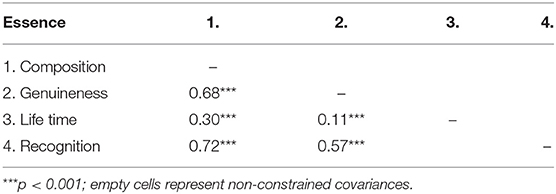
Table 16. Covariance matrix of the specific indicators of food reputation for the synthetic indicator ESSENCE of FRM-CHI–Study 3.
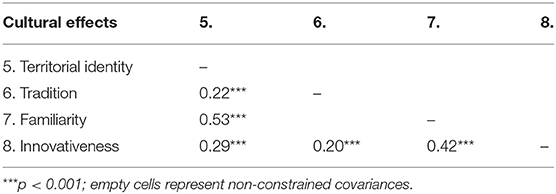
Table 17. Covariance matrix of the specific indicators of food reputation for the synthetic indicator CULTURAL EFFECTS of FRM-CHI–Study 3.

Table 18. Covariance matrix of the specific indicators of food reputation for the synthetic indicator ECONOMIC EFFECTS of FRM-CHI–Study 3.
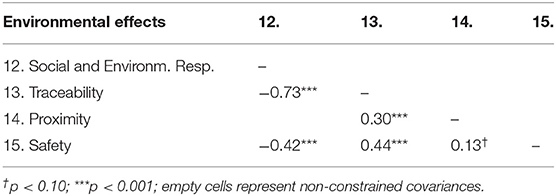
Table 19. Covariance matrix of the specific indicators of food reputation for the synthetic indicator ENVIRONMENTAL EFFECTS of FRM-CHI–Study 3.

Table 20. Covariance matrix of the specific indicators of food reputation for the synthetic indicator PHYSIOLOGICAL EFFECTS of FRM-CHI–Study 3.
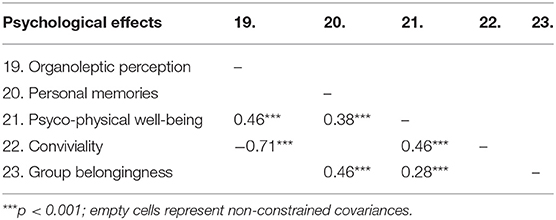
Table 21. Covariance matrix of the specific indicators of food reputation for the synthetic indicator PSYCHOLOGICAL EFFECTS of FRM-CHI–Study 3.
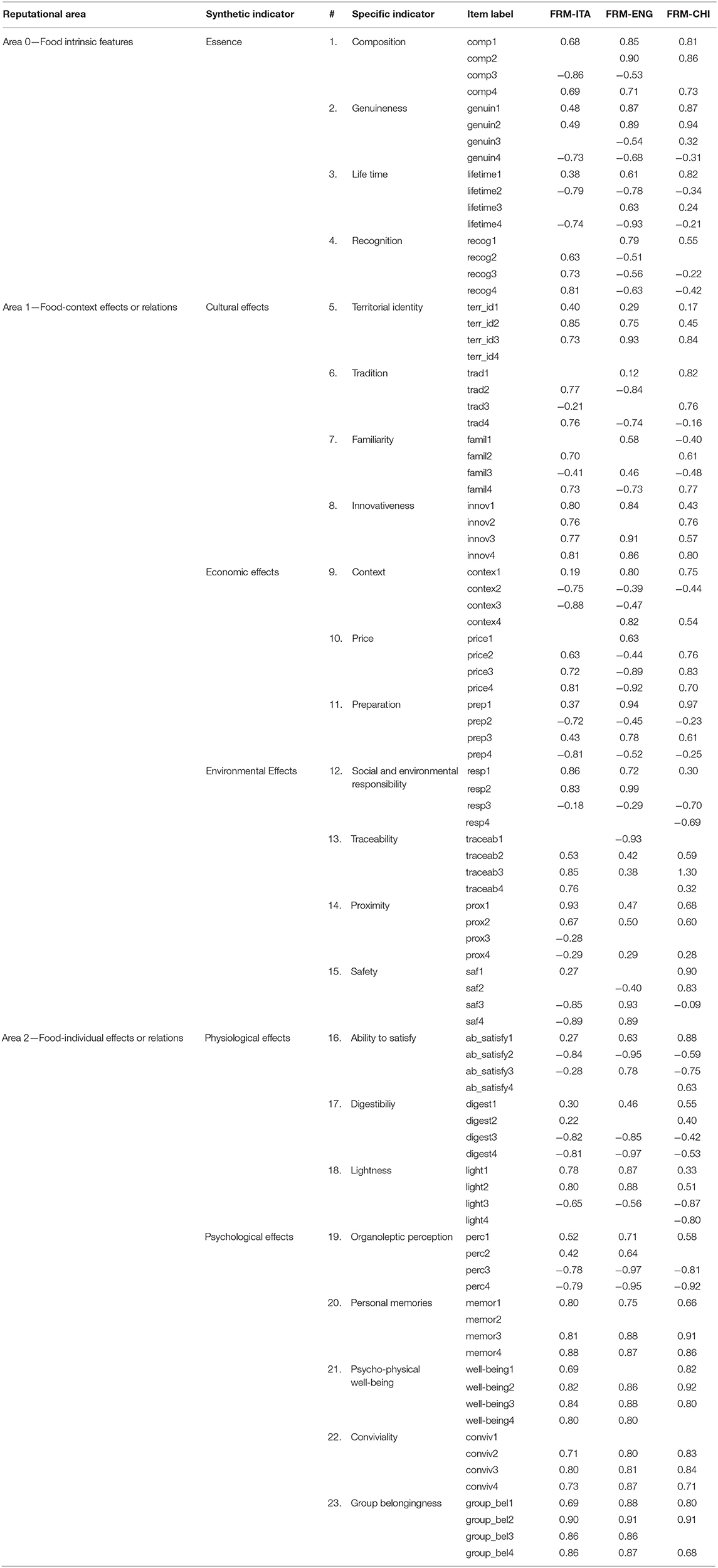
Table 22. Standardized lambda coefficients for each item and its specific indicator of food reputation in each version of the FRM.
Essence
For the scale measuring Essence, the model includes four correlated Specific Indicators of food reputation (factors): Composition (three items), Genuineness (four items), Life Time (four items), and Recognition (three items). The factors Life Time and Recognition were not significantly correlated.
Cultural Effects
For the scale measuring Cultural Effects, the model includes four correlated Specific Indicators of food reputation: Territorial Identity (three items), Tradition (three items), Familiarity (four items), and Innovativeness (four items).
Economic Effects
For the scale measuring Economic Effects, the model includes three correlated Specific Indicators of food reputation: Context (three items), Price (three items), and Preparation (four items).
Environmental Effects
For the scale measuring Environmental Effects, the model includes four correlated Specific Indicators of food reputation, each measured by three items: Social and Environmental Responsibility, Traceability, Proximity, and Safety. The factors Social and Environmental Responsibility and Proximity were not significantly correlated.
Physiological Effects
For the scale measuring Physiological Effects, the model includes three correlated Specific Indicators of food reputation, each measured by four items: Ability to Satisfy, Digestibility, and Lightness.
Psychological Effects
For the scale measuring Psychological Effects, the model includes five correlated Specific Indicators of food reputation, each measured by three items: Organoleptic Perception, Personal Memories, Psycho-physical Well-being, Conviviality, and Group Belongingness. The following correlations among factors were not significant: Organoleptic Perception-Personal Memories, Organoleptic Perception-Group Belongingness, Personal Memories-Conviviality, and Conviviality-Group Belongingness.
Conclusion
Similar to Studies 1 and 2, results of Study 3, based on a survey administered to an ad hoc sample of Chinese, generally confirms the measurement model theorized by the original FRM (Bonaiuto et al., 2017): the proposed models produced good fit indices (H1); first order factors (i.e., the Specific Indicators of Food Reputation) were all correlated in the following Synthetic Indicators of Food Reputation: Cultural Effects, Economic Effects, and Physiological Effects; and, a total of 77 items were retained (H3). In the finalized FRM-CHI, one item was removed from each of the following Specific Indicators of Food Reputation (the overarching group's Synthetic Indicator of Food reputation is indicated in brackets): Composition, Recognition (Essence); Territorial identity, Tradition (Cultural Effects); Context, Price (Economic Effects); Social and environmental responsibility, Traceability, Proximity, Safety (Environmental Effects); Organoleptic Perception, Personal memories, Psycho-Physical Well-being, Conviviality, Group Belongingness (Psychological Effects). The finalized FRM-CHI is presented in Appendix 1. In conclusion, Study 3 successfully defined the FRM-CHI.
Auxiliary Analysis
To further corroborate the importance of defining the three versions of the FRM, we conducted a post-hoc auxiliary analysis where we compared the Specific Indicators of food reputation describing the three aggregated product categories in the three countries. A series of 23 ANOVAs has been conducted to test for significant differences in each Specific Indicator of food reputation (of the three food categories aggregated) across the three cultural contexts. Specifically, in Figure 1, we show the statistical differences (one-way ANOVA and 95% confidence interval of the mean) among the three countries for each specific indicator of food reputation. Results show that some reputational features of the examined food products are indeed perceived differently across cultures (all p < 0.05): for example, Italians perceive Composition, Life Time, Familiarity, Social and Environmental Responsibility, Lightness and Psycho-Physical Well-being to be significantly lower than Americans and Chinese; Americans perceive Genuineness, Recognition, Familiarity, Price, Social and Environmental Responsibility, Traceability, Safety, Digestibility and Lightness to be significantly higher than Italians and Chinese; Chinese perceive Preparation and Ability to Satisfy to be significantly lower, while Innovativeness significantly higher than Italians and Americans. Furthermore, as an example, we suggest the visual representation of the FRM in the form of a Kiviat graph (Morris, 1974)—or radar chart (Figure 2)—to have a visual representation of the magnitude of each given product category's reputational profile.
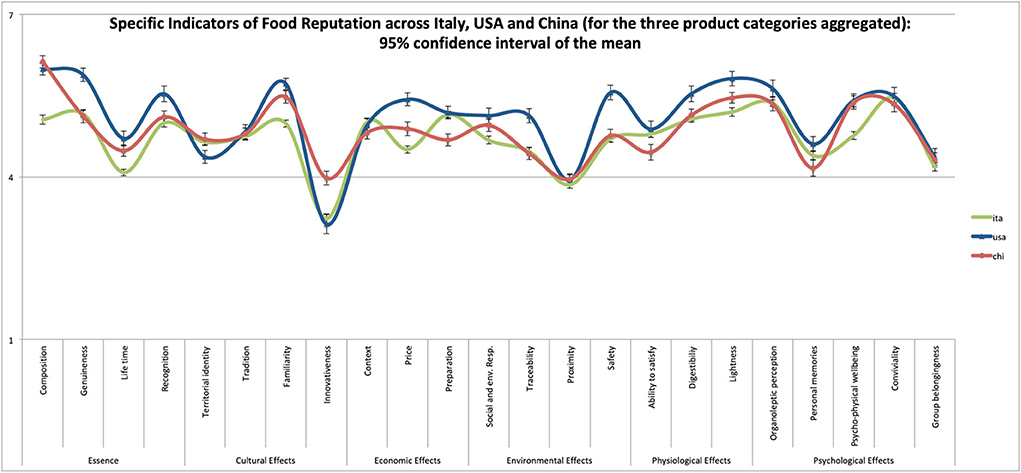
Figure 1. Statistical comparison of the three product categories aggregated across the three countries of Study 1, 2, and 3.
In conclusion, although the test of such statistical differences goes beyond the aim of the present research, we believe that such representation is a useful example to highlight one of the possible applications of the FRM. Results show that people's reputation of the food categories here examined changes significantly across different cultural contexts. These results, together with the fact that consumers increasingly demand local and traditional food (Pieniak et al., 2009), substantiate the idea that in order to understand people's actions in relation to food preferences and therefore food consumption, it is important to take into account the repertoire of cultural differences that underlies the contexts of analysis. In order to do so, the culture-specific measures of food-reputation here provided can therefore be very effective and useful tools to acquire such knowledge. In turn, the knowledge of culture-specific food perception could be indeed leveraged to promote a more sustainable consumption of food.
General Discussion
The three reported studies succeeded in validating the original model proposed for the FRM (Bonaiuto et al., 2017). Drawing on the idea that food can play different roles in different cultures, and therefore the concept of food reputation might change across different cultural settings, it is important to provide available tools capable of measuring food related constructs cross-culturally. The three versions of the Food Reputation Map, namely the FRM-ITA, FRM-ENG, and FRM-CHI in Italian, American English, and Mandarin Chinese, respectively, were created and validated by administration of the same FRM item sets in Italy, USA and China (Table 1). Together, the three studies represent a first attempt at creating a series of tools that could be applied in future studies for improving the understanding of individuals' food perceptions, assessments, and consumption. Overall, the three studies confirm the measurement structure of the FRM through the verification of the three operational hypotheses of the present research: in fact, model fit indexes, correlations among Specific Indicators of food reputation, and lambda coefficient—only with few exceptions in each context—were satisfactory and confirmed the original theoretical model of food reputation already presented in past research (Bonaiuto et al., 2012b,c, 2017). The Food Reputation Map theoretical model, encompassing twenty-three Specific Indicators, which can be further grouped into six Synthetic Indicators of food reputation, was replicated in the three different cultural contexts, keeping constant three target food categories. The results held across three diverse samples of Italian, American, and Chinese respondents.
According to the assumptions that (a) food is a social agent (Bonaiuto et al., 2017), (b) it is fundamentally linked to specific cultural settings (Counihan and Van Esterik, 2013), and (c) is subject to continuous change (Devine, 2005), the three measures of food reputation presented here can be applied to study food reputation according to, and within, different cultural settings. The finalized sets of items measure each of the twenty-three Specific Indicators of food reputation either by a three-item or four-item marker pool: such items, in each cultural setting, apparently have a different weight in measuring the specific indicator of food reputation. Also, results show that correlations among Specific Indicators of food reputation—which, according to the FRM model cluster into a Synthetic Indicator of food reputation—can change across cultural settings. These results support the idea that food reputation can be measured by a standard set of items and can be synthesized by the same set of Indicators (Specific and Synthetic ones). This tenet does not exclude the possibility that specific target food categories can also be defined and rated differently according to different cultural settings in terms of their respective food reputation: further research should investigate which parameters of food reputation are, on the one hand, context specific and which are, on the other hand, generalizable across cultures.
Limitations and Future Directions
The new and promising tools developed in this research should be considered in light of some limitations, which can guide future research developments for understanding both generalizable and context-specific features of food reputation. First, it should be noted that the new FRM measures developed here emerged from a testing involving specific samples in Italy, USA, and China (N = 1,337, 303, and 307, respectively), where participants responded to the specific survey in their own native language. Although the Italian sample was gathered by quota sampling in the Italian population across genders, ages, and main geographical areas, the American and Chinese samples were convenient samples (MTurk and college students, respectively). Whereas, the Italian sample could be considered representative of the Italian population (ISTAT, 2019) the American and Chinese sample might not be representative of their respective populations. Thus, future research should aim at replicating the FRM model within larger, representative sample within each context, possibly including various other socio-demographic information, such as ethnicity and immigration status to allow for a deeper understanding of how reputational features of a given food could be perceived differently within specific groups.
Second, the FRM tools developed in this research have referred to three different goods, namely vegetables, citrus fruit and peeled tomatoes, all very relevant goods for the Italian food market (Castiglione et al., 2007; Zaccarini Bonelli, 2012; Bonaiuto et al., 2017). However, these goods might not be central within other food markets in other cultural contexts, and therefore future research should consider how food reputation features are linked to products whose importance is more or less central within various specific cultural settings.
Also, as already pointed out in previous research (Bonaiuto et al., 2012b, 2017), the FRM model originated and has been developed from a set of initial researches (carried out with both qualitative and quantitative methodology) based in Italy (Bonaiuto et al., 2012a,b,c, 2017). Such a feature on the one hand is a strength considering the variety of approaches and methods used in its development; on the other hand, it could potentially represent a limiting factor in terms of cultural diversity. In fact, it is well-acknowledged that food is a fundamental aspect in the Italian culture (Parasecoli, 2004), and therefore it might be the case that some outcomes which emerged in the Italian sample could be culture-specific rather than cultural universals. Thus, a test of the FRM in other cultures is needed to generalize the validity of the FRM across different cultural and linguistic contexts, possibly considering classes of products, which are very relevant for those specific cultures, to assure the best benchmarking approach. Overall, the present research is a first attempt to set a standard measure, which can be used to assess this issue; however, future research should investigate whether other fundamental tenets of food reputation can arise in different contexts.
Furthermore, concerning factorial the structure of the FRM model, the second-order factors of food reputation (namely, the Synthetic Indicators) have not been discussed here—a goal that would have been out of the scope of the present manuscript. Rather, here we test which items of each Specific Indicator of food reputation (first-order factor) are indeed the most appropriate markers to measure the intended Specific Indicator within each culture. Future research should therefore confirm the second-order overall structure of the model in different cultural contexts. In addition, concerning the comparison between cultures, we assumed and demonstrated that the best item-markers for each Specific Indicator of food reputation can vary cross-culturally. However, one un-answered question is whether or not (and, if yes, which) facets of food reputation could be universally relevant: starting from the present results, future research should therefore test the multi-group invariance of the FRM model across different cultural groups.
Practical Implications
In spite of such limitations, the present tools set an effective and useful standard of measures, which can be implemented in various practical activities. A series of possible applications can be considered in light of these new tools, which are highlighted here in view of future developments.
At the consumer level, one possible application lies in the opportunity to gather new knowledge on different reputational features, or perceived features that can be linked to reputation (Péneau et al., 2006), which may affect consumer choices in different contexts (Bonaiuto et al., 2012b). This goal could be achieved, for example, by investigating a given product's reputation in two different cultural contexts to understand its culture-specific reputational features' strengths and weaknesses. Such a strategy could be used to address various issues. For example, it could help individuals' decision-making on how to self-regulate eating behaviors (Johnson et al., 2012); or it could shed light on how ethnic identity, socialization and other culture-specific behaviors affect food consumption (Xu et al., 2004); or, in more general terms, it could deepen our understanding of cultural specific influences of food reputation on the attitude-behavior consistency (Crano and Prislin, 2011) related to food choices.
From a marketing perspective, because in both physical and online markets peer-to-peer knowledge represents a fundamental asset for consumers and businesses to derive information related to reputation and trust (Ert et al., 2016), the knowledge and management of a given food product's reputational features can obviously be an important asset. Drawing upon the evidence that different food reputational features have different impacts on consumers' food choices (Bonaiuto et al., 2012b,c), food reputation management could be a very effective strategy for various stakeholders (e.g., businesses or consumers) to gain strategic advantage from their competitors. On the one hand, businesses could, for example, grow their own reputation (Riel and van Fombrun, 2007) by taking advantage of their products' best reputational features, or they could improve their own products' reputation by investing in specific weak reputational features to be addressed. On the other hand, specific clusters of consumers, such as athletes or clinical patients, could acquire knowledge about specific reputational features of a given product and then use this knowledge to their advantage (for example, for improving performance or for sticking to prescribed nutritional programs; e.g., Johnson et al., 2012).
At the broader perspective, policy makers, opinion-leaders and various institutional stakeholders can potentially use the present tools to promote well-being at the community level. In fact, the various reputational features of the food reputation model, confirmed here, could be studied to serve purposes related to, among others, community-based health interventions (Schulz et al., 2005; Ball et al., 2010; Brand et al., 2014), environmental sustainability (Tilman and Clark, 2014), and price control (UN World Food Programme, 2012). Indeed, one of the major strengths of our research lies in the fact that by considering all possible facets of food reputation (defined by the FRM), and by developing a culture-specific instrument measuring such facets (e.g., FRM-ENG), it would be possible to understand whether a specific reputational feature (e.g., Tradition) could be leveraged to promote for example health or sustainable consumption at the community level in a given culture. We could draw upon the example of the Specific Indicator “Tradition”: although it has been often argued that there is no real cuisine tradition in the U.S. (e.g., Mintz, 2002), results of our Auxiliary analysis show no significant differences in Tradition across the three different cultures. This specific result could indicate that, despite that perhaps Italy and China have (at least historically) greater food traditions than the U.S., this is not reflected in the perceptions of individuals. Findings like this can inform marketers, practitioners, and policymakers alike to engage in more informed actions and solutions toward healthier, more sustainable and better informed food-related decisions.
Within this approach, the study of food reputational features could indeed be leveraged to promote food sustainability in a variety of ways. For example, provided that information about sustainability are communicated to consumers, consumption behaviors might have a major role in bringing about more sustainable food production (Grunert, 2011). Past research has already shown that some perceived features of food, such as food safety, environmental concern, nutritive value, taste, freshness and appearance—that are, arguably, very much comparable to the reputational features by the FRM, might influence organic food consumer preferences (Shafie and Rennie, 2012). However, how individuals can be encouraged to cut unsustainable consumption behavior (e.g., excessive meat consumption) has been underexplored, and more in-depth studies on the factors that could increase people's willingness to engage in a more sustainable food consumption are much needed (Hartmann and Siegrist, 2017). We argue that, ideally, the FRM model could be used to develop international evidence-based knowledge, which in turn could inform and support international exchange of information and effective policy design on drivers of sustainable consumer behavior and evaluations across countries worldwide (McGeevor, 2009).
Conclusion
From a social-psychological perspective, understanding processes driving individuals' food preferences and food consumption (i.e., food consumer behavior), food markets, and political decision-making is an important asset to be developed. The fundamental importance of understanding the cultural specificity of food reputation (Parasecoli, 2004), is reflected in the assumption that human behavior can only exists in a given place, and therefore it is both the product of, and it produces, a whole series of transactions between individuals and the specific environments where their behavior occurs (Proshansky et al., 1970; Bronfenbrenner, 1977; Bonnes and Secchiaroli, 1995; Bonnes and Bonaiuto, 2002; Devine-Wright, 2013). The global issues and challenges related to food consumption must be faced by interdisciplinary efforts and tackled by multiple perspectives (FAO, 2009). On the one hand, a stunning 113 million people across 53 countries are suffering acute hunger (Global Report on Food Crises, 2019); on the other hand, trend forecasts suggest that by 2030, 51% of the population will be obese (Finkelstein et al., 2012). In this respect, the crucial importance of food reputation lies in both its theoretical and applied implications for understanding food consumption choices and behaviors. By drawing upon the present research program, and by further developing the measures provided, the detailed and specific knowledge capital that could be derived provides the initial building blocks for a number of new possible interventions and action plans designed to tackle the current global food–related challenges, and potentially be leveraged to foster food sustainability. From a behavioral science perspective, whether in the realm of the consumption, production, marketing, political, or clinical intervention over food and drink matters, a “think global, act local” approach (Devine-Wright, 2013) could materially facilitate the development of international sustainable solutions to some of the global challenges related to food.
Data Availability Statement
The raw data supporting the conclusions of this article will be made available by the authors, without undue reservation.
Ethics Statement
Ethical review and approval was not required for the study on human participants in accordance with the local legislation and institutional requirements. Written informed consent for participation was not required for this study in accordance with the national legislation and the institutional requirements.
Author Contributions
SD and MB designed the research questions and the study. SD, MB, FF, WC, and JM supervised the data collection. SD performed the statistical analysis to discuss with MB and FF for interpretation and drafted the manuscript. WC, FF, and MB provided the feedback on the manuscript. SD, FB, UG, and IP contributed to the data collection. All authors contributed to the article and approved the submitted version.
Funding
This research was carried out by developing tools and procedures created within previous funding received from Nestlé Italiana S.p.A. (Grant Food Reputation Map: Sviluppo per il Progetto Axía 2013), awarded to the last author as a first development of an initial grant within the same programme. Its contents are the responsibility of this article's authors and do not necessarily represent the position of the funding body and initiative. Special thanks to Manuela Kron (Corporate Affairs Director at Nestlé Italiana S.p.A.) and Alessandra Medolago Albani (Partner and CEO at Cantiere di Comunicazione—TakeGroup) for their support, feedback, and discussion across several meetings. A further partial support for the research presented here was made possible thanks to Sapienza Università di Roma (Grant Food Reputation Map: sviluppo dello strumento, Year 2014—prot. C26A1482K4) awarded to the last author. Moreover, both incoming and outgoing staff international mobility and collaborations were funded by Sapienza Università di Roma with both China (Grant Accordi Interuniversitari di Collaborazione Culturale e Scientifica Internazionali con Zhejiang University, China, Year 2014—Prot. AI2614MWLJ) and USA (Grant Accordi Interuniversitari di Collaborazione Culturale e Scientifica Internazionali con Claremont Graduate University, USA, Year 2015—Prot. AI2615KLJA): those two mobility grants for staff—and their corresponding graduate students mobility grants which funded 3-months fellowships abroad to Italian master students gathering data in USA and in China—were awarded to the last author.
Conflict of Interest
The authors declare that the research was conducted in the absence of any commercial or financial relationships that could be construed as a potential conflict of interest.
Acknowledgments
The authors were grateful to Ms. Marianna Nicolai and to Mr. Matteo Guaita for their help in data gathering while studying abroad for their master thesis dissertation (respectively in China during 2015 and in USA during 2016).
Supplementary Material
The Supplementary Material for this article can be found online at: https://www.frontiersin.org/articles/10.3389/fpsyg.2020.01499/full#supplementary-material
References
Bagozzi, R. P., Yi, Y., and Phillips, L. W. (1991). Assessing construct validity in organizational research. Adm. Sci. Q. 36, 421–458. doi: 10.2307/2393203
Ball, K., Jeffery, R. W., Abbott, G., McNaughton, S. A., and Crawford, D. (2010). Is healthy behavior contagious: associations of social norms with physical activity and healthy eating. Int. J. Behav. Nutr. Phys. Act. 7:86. doi: 10.1186/1479-5868-7-86
Bonaiuto, M., Bonnes, M., Carrus, G., Fornara, F., Bonaiuto, F., Caddeo, P., et al. (2012a). “La reputazione dei cibi nei processi di decisione di consumo alimentare,” in Imparare Dalla Diversità, Creare Valore per l'Itala, ed A. A. V. V. Axìa (Palermo: Qanat), 121–169.
Bonaiuto, M., Caddeo, P., Carrus, G., De Dominicis, S., Maroni, B., and Bonnes, M. (2012b). Food reputation impacts on consumer's food choice. Corp. Commun. Int. J. 17, 462–482. doi: 10.1108/13563281211274158
Bonaiuto, M., De Dominicis, S., Caddeo, P., and Troffa, R. (2012c). “A mixed method parroach to investigate food reputation in young consumers' choice,” in Proceedings of the Child and Teen Consumption 2012 “Food Consumption, Communication, Life Styles and Fashion”, eds M. Bustreo and V. Russo (Palermo: Qanat), 711–729.
Bonaiuto, M., De Dominicis, S., Fornara, F., Ganucci Cancellieri, U., Petruccelli, I., and Bonaiuto, F. (2017). Food reputation map (FRM): Italian long and short versions' psychometric features. Food Qual. Prefer. 59, 156–167. doi: 10.1016/j.foodqual.2017.02.004
Bonnes, M., and Bonaiuto, M. (2002). “Environmental psychology: from spatial-physical environment to sustainable development,” in Handbook of Environmental Psychology, eds R. B. Bechtel and A. Churchman (New York, NY: Wiley) 28–54.
Bonnes, M., and Secchiaroli, G. (1995). Environmental Psychology: A Psycho-social Introduction. London: SAGE.
Brand, T., Pischke, C. R., Steenbock, B., Schoenbach, J., Poettgen, S., Samkange-Zeeb, F., et al. (2014). What works in community-based interventions promoting physical activity and healthy eating? A review of reviews. Int. J. Environ. Res. Public. Health 11, 5866–5888. doi: 10.3390/ijerph110605866
Bromley, D. B. (2001). Relationships between personal and corporate reputation. Eur. J. Mark. 35, 316–334. doi: 10.1108/03090560110382048
Bronfenbrenner, U. (1977). Toward an experimental ecology of human development. Am. Psychol. 32, 513–531. doi: 10.1037/0003-066X.32.7.513
Buhrmester, M., Kwang, T., and Gosling, S. D. (2011). Amazon's mechanical turk: a new source of inexpensive, yet high-quality, data? Perspect. Psychol. Sci. 6, 3–5. doi: 10.1177/1745691610393980
Carfora, V., Bertolotti, M., and Catellani, P. (2019). Informational and emotional daily messages to reduce red and processed meat consumption. Appetite 141:104331. doi: 10.1016/j.appet.2019.104331
Castiglione, E., Borriello, R., Napoletano, M. R., and Pittiglio, L. (2007). Gli Acquisti Alimentari in Italia: Tendenze Recenti e Nuovi Profili di Consumo. Rome: ISMEA.
Chou, C.-P., and Bentler, P. M. (1990). Model modification in covariance structure modeling: a comparison among likelihood ratio, lagrange multiplier, and wald tests. Multivar. Behav. Res. 25, 115–136. doi: 10.1207/s15327906mbr2501_13
Conner, M., and Armitage, C. J. (2002). The Social Psychology of Food. Buckingham: Open University Press.
Corral-Verdugo, V. (2002). “Structural equation modeling,” in Handbook of Environmental Psychology, eds R. Bechtel and A. Churchman (New York, NY: Wiley), 256–270.
Counihan, C., and Van Esterik, P. (Eds.). (2013). Food and Culture: A Reader. 3rd Edn. New York, NY: Routledge.
Crano, W. D., and Prislin, R. (2011). Attitudes and Attitude Change. New York, NY: Psychology Press.
Devine, C. M. (2005). A life course perspective: understanding food choices in time, social location, and history. J. Nutr. Educ. Behav. 37, 121–128. doi: 10.1016/S1499-4046(06)60266-2
Devine-Wright, P. (2013). Think global, act local? The relevance of place attachments and place identities in a climate changed world. Glob. Environ. Change 23, 61–69. doi: 10.1016/j.gloenvcha.2012.08.003
DNPAO (2019). DNPAO Data, Trends and Maps: Explore by Location. CDC. Available online at: https://nccd.cdc.gov/dnpao_dtm/rdPage.aspx?rdReport=DNPAO_DTM.ExploreByLocation&rdRequestForwarding=Form (accessed July 5, 2019).
Emler, N. (1990). A social psychology of reputation. Eur. Rev. Soc. Psychol. 1, 171–193. doi: 10.1080/14792779108401861
Ert, E., Fleischer, A., and Magen, N. (2016). Trust and reputation in the sharing economy: the role of personal photos in Airbnb. Tour. Manag. 55, 62–73. doi: 10.1016/j.tourman.2016.01.013
FAO (Ed.). (2009). In Proceedings of the Expert Meeting on How to Feed the World in 2050: 24–26 June 2009, FAO Headquarters, Rome (Rome: FAO).
Finkelstein, E. A., Khavjou, O. A., Thompson, H., Trogdon, J. G., Pan, L., Sherry, B., et al. (2012). Obesity and severe obesity forecasts through 2030. Am. J. Prev. Med. 42, 563–570. doi: 10.1016/j.amepre.2011.10.026
Fornara, F., Bonaiuto, M., and Bonnes, M. (2010). Cross-validation of abbreviated perceived residential environment quality (PREQ) and neighborhood attachment (NA) indicators. Environ. Behav. 42, 171–196. doi: 10.1177/0013916508330998
Global Report on Food Crises (2019). Available online at: http://www.fsinplatform.org/report/global-report-food-crisis-2019/ (accessed June 12, 2019).
Grunert, K. G. (2011). Sustainability in the food sector: a consumer behaviour perspective. Int. J. Food Syst. Dyn. 2, 207–218. doi: 10.18461/ijfsd.v2i3.232
Hartmann, C., and Siegrist, M. (2017). Consumer perception and behaviour regarding sustainable protein consumption: a systematic review. Trends Food Sci. Technol. 61, 11–25. doi: 10.1016/j.tifs.2016.12.006
Hawkes, C., Smith, T. G., Jewell, J., Wardle, J., Hammond, R. A., Friel, S., et al. (2015). Smart food policies for obesity prevention. Lancet 385, 2410–2421. doi: 10.1016/S0140-6736(14)61745-1
Hu, L., and Bentler, P. M. (1999). Cutoff criteria for fit indexes in covariance structure analysis: conventional criteria versus new alternatives. Struct. Equ. Model. Multidiscip. J. 6, 1–55. doi: 10.1080/10705519909540118
ISTAT (2019). Indicatori Demografici. dati.istat.it. Available online at: http://dati.istat.it/Index.aspx?QueryId=18462 (accessed April 11, 2019).
Johnson, F., Pratt, M., and Wardle, J. (2012). Dietary restraint and self-regulation in eating behavior. Int. J. Obes. 36, 665–674. doi: 10.1038/ijo.2011.156
McGeevor, K. (2009). Designing Policy to Influence Consumers: Consumer Behaviour Relating to the Purchasing of Environmentally Preferable Goods. London: Policy Studies Institute. Available online at: http://ec.europa.eu/environment/enveco/pdf/RealWorldConsumerBehaviour.pdf (accessed June 1, 2020).
Mintz, S. (2002). “Eating America,” in Food in the USA: A Reader, ed C. Counihan (New York, NY: Routledge) 23–34.
Morris, M. F. (1974). Kiviat graphs: conventions and “figures of merit.” SIGMETRICS Perform. Eval. Rev. 3, 2–8. doi: 10.1145/1041691.1041692
Moscovici, S. (1988). Notes towards a description of Social Representations. Eur. J. Soc. Psychol. 18, 211–250. doi: 10.1002/ejsp.2420180303
Péneau, S., Hoehn, E., Roth, H.-R., Escher, F., and Nuessli, J. (2006). Importance and consumer perception of freshness of apples. Food Qual. Prefer. 17, 9–19. doi: 10.1016/j.foodqual.2005.05.002
Pieniak, Z., Verbeke, W., Vanhonacker, F., Guerrero, L., and Hersleth, M. (2009). Association between traditional food consumption and motives for food choice in six European countries. Appetite 53, 101–108. doi: 10.1016/j.appet.2009.05.019
Proshansky, H. M., Ittelson, W., and Rivling, A. (Eds.). (1970). Environmental Psychology: Man and His Physical Setting. New York, NY: Holt, Rinehart & Winston.
Rand, D. G. (2012). The promise of mechanical turk: how online labor markets can help theorists run behavioral experiments. J. Theor. Biol. 299, 172–179. doi: 10.1016/j.jtbi.2011.03.004
Riel, C. B. M., and van Fombrun, C. J. (2007). Essentials of Corporate Communication: Implementing Practices for Effective Reputation Management. London; New York, NY: Routledge.
Rozin, P. (2007). “Food and eating,” in Handbook of Cultural Psychology, eds S. Kitayama and D. Cohen (New York, NY: Guilford Press) 391–416.
Schreiber, J. B., Nora, A., Stage, F. K., Barlow, E. A., and King, J. (2006). Reporting structural equation modeling and confirmatory factor analysis results: a review. J. Educ. Res. 99, 323–338. doi: 10.3200/JOER.99.6.323-338
Schulz, A. J., Zenk, S., Odoms-Young, A., Hollis-Neely, T., Nwankwo, R., Lockett, M., et al. (2005). Healthy eating and exercising to reduce diabetes: exploring the potential of social determinants of health frameworks within the context of community-based participatory diabetes prevention. Am. J. Public Health 95, 645–651. doi: 10.2105/AJPH.2004.048256
Shafie, F. A., and Rennie, D. (2012). Consumer perceptions towards organic food. Proc. Soc. Behav. Sci. 49, 360–367. doi: 10.1016/j.sbspro.2012.07.034
Siegel, J. T., Donaldson, C. D., and Crano, W. D. (2019). Application of vested interest theory to prevention of non-medical prescription stimulant and marijuana use: unforeseen benefits of attitude-behavior inconsistency. Drug Alcohol Depend. 194, 210–215. doi: 10.1016/j.drugalcdep.2018.10.007
Tilman, D., and Clark, M. (2014). Global diets link environmental sustainability and human health. Nature 515, 518–522. doi: 10.1038/nature13959
UN World Food Programme (2012). How High Food Prices Affect The World's Poor. Available online at: https://reliefweb.int/report/world/how-high-food-prices-affect-world%E2%80%99s-poor (accessed June 12, 2019).
Vermeir, I., and Verbeke, W. (2006). Sustainable food consumption: exploring the consumer “attitude–behavioral intention” gap. J. Agric. Environ. Ethics 19, 169–194. doi: 10.1007/s10806-005-5485-3
WHO (2019). WHO|Overweight and Obesity. WHO. Available online at: http://www.who.int/gho/ncd/risk_factors/overweight/en/ (accessed July 5, 2019).
Xu, J., Shim, S., Lotz, S., and Almeida, D. (2004). Ethnic identity, socialization factors, and culture-specific consumption behavior. Psychol. Mark. 21, 93–112. doi: 10.1002/mar.10117
Keywords: food reputation map, reputation, food preferences, consumer behavior, cultural differences, food choices, measure, food behavior
Citation: De Dominicis S, Bonaiuto F, Fornara F, Ganucci Cancellieri U, Petruccelli I, Crano WD, Ma J and Bonaiuto M (2020) Food Reputation and Food Preferences: Application of the Food Reputation Map (FRM) in Italy, USA, and China. Front. Psychol. 11:1499. doi: 10.3389/fpsyg.2020.01499
Received: 19 March 2020; Accepted: 04 June 2020;
Published: 14 July 2020.
Edited by:
Valentina Carfora, Catholic University of the Sacred Heart, ItalyReviewed by:
Junilla Kirsten Larsen, Radboud University Nijmegen, NetherlandsKeiko Goto, California State University, United States
Copyright © 2020 De Dominicis, Bonaiuto, Fornara, Ganucci Cancellieri, Petruccelli, Crano, Ma and Bonaiuto. This is an open-access article distributed under the terms of the Creative Commons Attribution License (CC BY). The use, distribution or reproduction in other forums is permitted, provided the original author(s) and the copyright owner(s) are credited and that the original publication in this journal is cited, in accordance with accepted academic practice. No use, distribution or reproduction is permitted which does not comply with these terms.
*Correspondence: Stefano De Dominicis, c2RkJiN4MDAwNDA7bmV4cy5rdS5kaw==
 Stefano De Dominicis
Stefano De Dominicis Flavia Bonaiuto
Flavia Bonaiuto Ferdinando Fornara
Ferdinando Fornara Uberta Ganucci Cancellieri
Uberta Ganucci Cancellieri Irene Petruccelli
Irene Petruccelli William D. Crano
William D. Crano Jianhong Ma
Jianhong Ma Marino Bonaiuto
Marino Bonaiuto